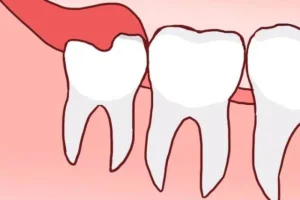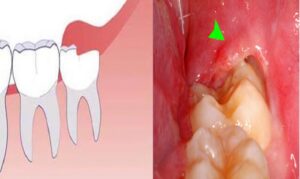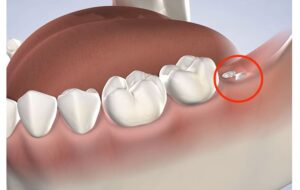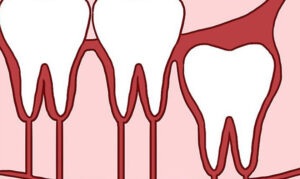A straight-growing wisdom tooth is considered a rare and fortunate case in dental health, especially when compared to impacted or misaligned wisdom teeth that often cause significant pain and complications. This leads many people to wonder: Is it necessary to remove a straight growing wisdom tooth? Since it doesn’t cause as much discomfort, is it safe to keep? Let’s explore this topic with Joy International Dental Clinic to find out the best course of action.
1. Is a Straight Growing Wisdom Tooth Harmful to Oral Health?

Wisdom teeth, also known as the third molars or tooth number 8, are the last set of teeth to emerge, usually between the ages of 18 and 25. Unlike impacted or misaligned wisdom teeth—which can cause pain, swelling, and even infection—straight-growing wisdom teeth are often assumed to be harmless.
However, even if they grow in the right direction, they are not always entirely safe. In some cases, a straight-growing wisdom tooth may still:
-
Be located too deep within the jaw, making it difficult to clean thoroughly.
-
Have a large root structure that can press against adjacent teeth, potentially leading to misalignment or periodontal (gum) disease.
-
Be prone to plaque accumulation due to its position at the back of the mouth, which fosters the growth of harmful bacteria. This can cause tooth decay, gum inflammation, and even damage the adjacent second molar (tooth number 7).
For these reasons, regular dental check-ups are essential even if your wisdom tooth appears to be growing normally. Your dentist can monitor for hidden risks and recommend preventive measures early on.
2. Is It Always Necessary to Extract a Straight Growing Wisdom Tooth?

Not every straight wisdom tooth needs to be removed. The decision to extract depends on several factors, including the direction of growth, size and shape of the tooth, its root structure, and whether it affects the surrounding teeth or the alignment of your bite.
2.1 In case straight growing wisdom tooth, we need to be removed
Even if the tooth is growing straight, dentists may advise removal in the following situations:
-
The tooth is too deeply positioned, making proper cleaning difficult. This leads to plaque buildup, increasing the risk of cavities and gum infections.
-
The roots are abnormally large, which can push against adjacent teeth and cause shifting or bite misalignment.
-
The tooth is pressing on the mandibular nerve, resulting in symptoms like jaw pain, headaches, or even reduced chewing efficiency.
-
The tooth shows signs of decay, pulp inflammation, or infection, which could spread to neighboring teeth if not treated promptly.
-
You are undergoing orthodontic treatment, and space is needed to align your teeth properly.
In these cases, extraction is often the safest and most practical solution to prevent more severe oral health issues.
2.2 When Extraction May Not Be Necessary
On the other hand, if your wisdom tooth:
-
Grows completely straight,
-
Does not cause any pain, swelling, or infection,
-
And doesn’t interfere with surrounding teeth,
Then removal might not be necessary. In such scenarios, the tooth can remain safely in the jaw as long as it is regularly monitored and maintained. Some individuals may experience minor gum overgrowth (pericoronitis), which can often be resolved with a simple gum trimming procedure rather than extraction.
Still, it’s crucial to visit your dentist every six months for routine check-ups. This ensures your wisdom teeth are not silently contributing to any future dental problems.
3. Does Extracting a Straight Wisdom Tooth Hurt?

Fear of pain is one of the most common concerns when it comes to wisdom tooth removal. The good news is that extracting a straight wisdom tooth is usually much simpler and less painful than removing an impacted or misaligned one.
At Joy International Dental Clinic, the extraction process is performed under modern, sterile conditions with advanced equipment. Our highly experienced dental team uses local anesthesia, ensuring you won’t feel any significant discomfort during the procedure.
Typically, the procedure takes just 3 to 5 minutes for a straight-growing wisdom tooth. After the extraction, you’ll receive detailed post-operative care instructions to speed up healing and minimize any discomfort.
Once the anesthesia wears off, you might feel slight soreness or swelling around the extraction site. But don’t worry—this is entirely manageable. Pain relief medication, proper oral hygiene, and a bit of rest will help you recover quickly and comfortably.
4. How Are Straight Wisdom Teeth Different?

Compared to impacted or angled wisdom teeth, straight-growing ones usually:
-
Cause fewer symptoms,
-
Are easier to monitor and maintain,
-
And may not require removal if they’re not causing issues.
However, that doesn’t mean they are risk-free.
A key challenge is that these teeth still emerge after your jaw and dental structure have fully developed, meaning there might not be enough room for them to erupt cleanly. Even when growing straight, they can cause crowding, bite misalignment, or hygiene difficulties—all of which can lead to complications if ignored.
Furthermore, wisdom teeth often have complex shapes and multiple roots, which makes dental treatments like fillings or root canals more challenging if they become damaged or decayed.
Conclusion
While straight-growing wisdom teeth are generally less troublesome than their misaligned counterparts, they still come with potential risks. Whether to keep or remove such a tooth should be determined by a professional dental evaluation.
To protect your long-term oral health, don’t wait until pain or complications arise. Schedule a consultation with a trusted dental provider like Joy International Dental Clinic to assess your situation accurately.
Have more questions? Feel free to contact us for expert advice and timely support. Your smile deserves the best care!






